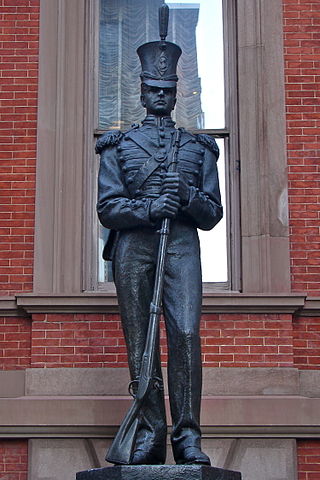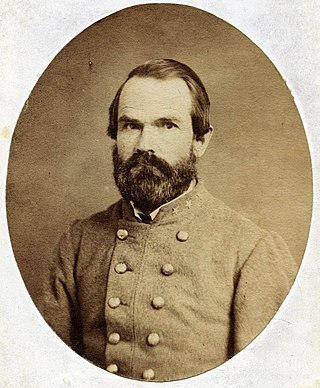Related Research Articles

The U.S. state of West Virginia was formed out of western Virginia and added to the Union as a direct result of the American Civil War, in which it became the only modern state to have declared its independence from the Confederacy. In the summer of 1861, Union troops, which included a number of newly formed Western Virginia regiments, under General George McClellan drove off Confederate troops under General Robert E. Lee at the Battle of Philippi in Barbour County. This essentially freed Unionists in the northwestern counties of Virginia to form a functioning government of their own as a result of the Wheeling Convention. Before the admission of West Virginia as a state, the government in Wheeling formally claimed jurisdiction over all of Virginia, although from its creation it was firmly committed to the formation of a separate state.

The 1st Ohio Infantry Regiment was an infantry regiment in the Union Army during the American Civil War. It served in the Western Theater in a number of campaigns and battles.

During the American Civil War, the State of Ohio played a key role in providing troops, military officers, and supplies to the Union army. Due to its central location in the Northern United States and burgeoning population, Ohio was both politically and logistically important to the war effort. Despite the state's boasting a number of very powerful Republican politicians, it was divided politically. Portions of Southern Ohio followed the Peace Democrats and openly opposed President Abraham Lincoln's policies. Ohio played an important part in the Underground Railroad prior to the war, and remained a haven for escaped and runaway slaves during the war years.
The 4th Ohio Infantry Regiment was an infantry regiment in the Union Army during the American Civil War. It served in the Eastern Theater in a number of campaigns and battles, but perhaps is most noted for its actions in helping secure Cemetery Hill during the Battle of Gettysburg.

The 6th Ohio Infantry Regiment was a regiment in the Union Army during the American Civil War, primarily serving in the Western Theater in a series of campaigns and battles.

The 71st New York Infantry Regiment is an organization of the New York State Guard. Formerly, the 71st Infantry was a regiment of the New York State Militia and then the Army National Guard from 1850 to 1993. The regiment was not renumbered during the early 1920s Army reorganization due to being broken up to staff other units from 1917 to 1919, and never received a numerical designation corresponding to that of a National Guard regiment.
The 66th Illinois Veteran Volunteer Infantry Regiment (Western Sharpshooters) originally known as Birge's Western Sharpshooters and later as the "Western Sharpshooters-14th Missouri Volunteers", was a specialized regiment of infantry sharpshooters that served in the Union Army during the American Civil War. The regiment was intended, raised, and mustered into Federal service as the Western Theater counterpart to Army of the Potomac's 1st and 2nd United States Volunteer Sharpshooters ("Berdan's Sharpshooters").

The present-day state of Nebraska was still a territory of the United States during the American Civil War. It did not achieve statehood until March 1867, two years after the war ended. Nevertheless, the Nebraska Territory contributed significantly to the Union war effort.

32nd Regiment Indiana Volunteer Infantry was a Union Army infantry regiment during the American Civil War. It was also known as Indiana's "1st German" regiment because its members were mainly of German descent. Organized at Indianapolis, the regiment's first recruits mustered into service on August 24, 1861. From 1861 to 1865, the 32nd Indiana was attached to the first Army of the Ohio and the Army of the Cumberland, where it served in the Western Theater.

The 5th Ohio Infantry Regiment was an infantry regiment from southwestern Ohio that served in the Union Army during the American Civil War, serving in both the Eastern and Western Theaters in a series of campaigns and battles. It was noted for its holding the high ground at the center of the line at Antietam as part of Tyndale's 1st Brigade, Greene's 2nd Division of Mansfield's XII Corps.
The 258th Field Artillery Regiment or "Washington Greys" is a field artillery unit of the New York Army National Guard that traces its lineage from 1789 to present. Circa 1957–1966 it consisted of four battalions.
The 63rd Ohio Infantry Regiment was an infantry regiment which served in the Union Army during the American Civil War. It was a part of the Union forces in the Western Theater of operations.
The 2nd Missouri Infantry Regiment was an infantry regiment, formed from a voluntary regiment using the same name, that served in the Union Army during the American Civil War.
The 2nd Ohio Cavalry Regiment was a cavalry regiment that served in the Union Army during the American Civil War.

Ephraim Cutler Dawes was a major in the 53rd Ohio Infantry and brevet lieutenant-colonel, United States Volunteers, during the American Civil War. Dawes was present at the Battle of Shiloh and Battle of Vicksburg, among others, serving under Ulysses S. Grant and William T. Sherman. One of his notable acts occurred during battle, where Dawes disobeyed and cursed an officer who had become scared and disoriented. While serving with Sherman during his march to Atlanta Dawes was seriously wounded in his lower jaw in what would be his last battle, subsequently being honorably discharged in 1864.

The Washington Grays of Philadelphia, also known as Volunteer Corps of Light Infantry, Light Artillery Corps, Washington Grays, Artillery Corps, Washington Grays, was a volunteer regiment of the United States. Formed in 1822 in Philadelphia, the regiment became part of the Pennsylvania National Guard in 1879.
The following list is a Bibliography of American Civil War Union military unit histories. More details on each book are available at WorldCat.

The 82nd New York Infantry Regiment, the "Second Militia," "Second Regiment N. Y. S. Light Infantry," or "State Guards", was an infantry regiment of the Union Army during the American Civil War.

James McCown was a Confederate States Army officer in the American Civil War.

The 623rd Field Artillery Regiment (Morgan's Men) is a single-battalion unit of the Kentucky Army National Guard. The unit draws its lineage from cavalry and infantry units of the Kentucky Militia formed in 1846 for service in the Mexican–American War. Its antecedents include units that served on both sides of the American Civil War as well as those that fought for the United States in the Spanish–American War, World War One and World War Two. The unit was first designated as the 623rd Field Artillery Battalion in 1947, serving under that name in the Korean War. It was part of the 138th Artillery Regiment in the 1960s before becoming the 623rd Artillery Regiment in 1969 and the 623rd Field Artillery Regiment in 1972. The unit served in the Gulf War as a self-propelled artillery unit; it is now equipped with the M142 HIMARS system.
References
- ↑ Prokopowicz, Gerald (2014). All for the Regiment: The Army of the Ohio, 1861–1862. University of North Carolina Press. pp. 25–26. ISBN 978-1469620305.
- ↑ Mann, Joshua (Winter 2006). "Battalion embodies flexibility during past 15 years" (PDF). Buckeye Guard. Retrieved December 15, 2016.
- ↑ Hannaford (1868). The Story of a Regiment.
- ↑ Dean, John Ward; Folsom, George; Shea, John Gilmary; Stiles, Henry Reed; Dawson, Henry Barton (February 1869). The Historical Magazine: And Notes and Queries Concerning the Antiquities, History, and Biography of America. p. 156.